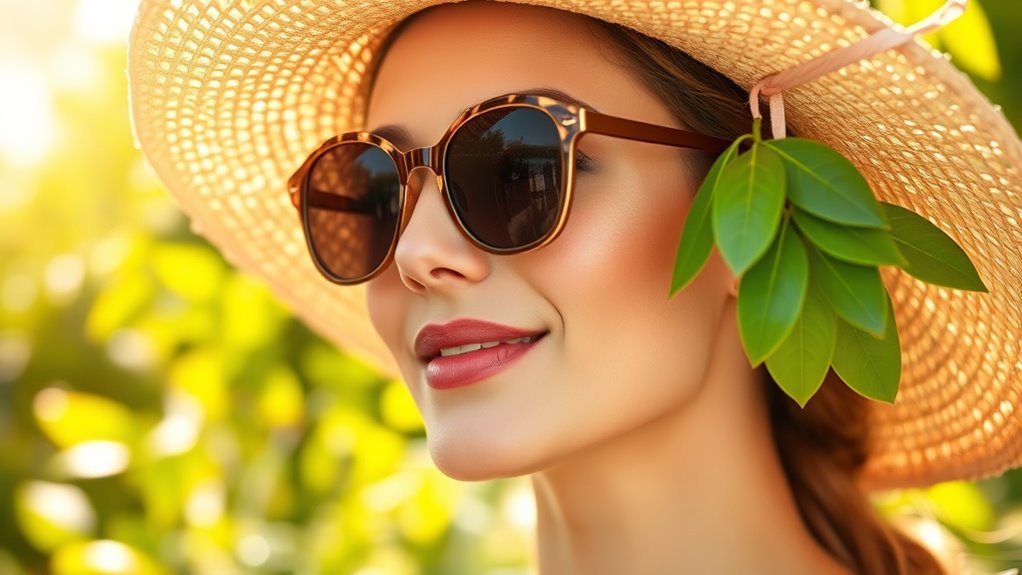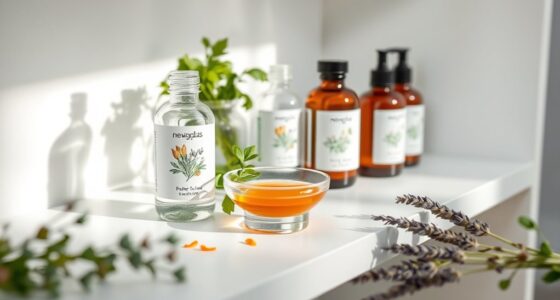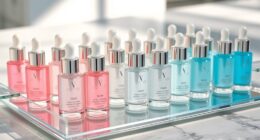Sun protection is essential for maintaining healthy skin and preventing long-term damage. UV rays can cause premature wrinkles, dark spots, and even skin cancer by damaging DNA in your skin cells. Choosing the right sunscreen, wearing protective clothing, and avoiding peak sun hours help shield your skin effectively. Consistent sun safety habits now can save you from costly treatments later. Keep exploring to discover simple ways to boost your daily sun defense.
Key Takeaways
- UV rays damage skin DNA, accelerating aging and increasing skin cancer risk.
- Consistent sun protection prevents premature wrinkles, dark spots, and maintains skin elasticity.
- Broad-spectrum sunscreens shield against UVA and UVB rays, reducing long-term skin damage.
- Protective clothing and timing outdoor activities lower UV exposure during peak hours.
- Regular sun safety habits support overall skin health and prevent costly dermatological issues later.
The Impact of UV Rays on Skin Health
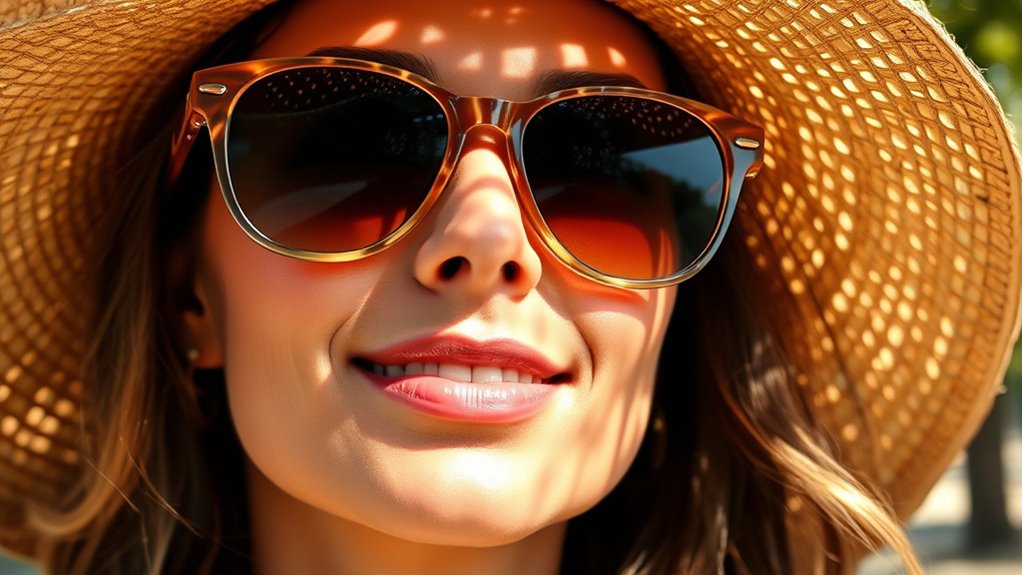
Ultraviolet (UV) rays from the sun directly damage your skin cells, accelerating aging and increasing the risk of skin cancer. When you’re exposed to UV radiation, it penetrates your skin and damages the DNA in your skin cells. Over time, this damage can lead to premature wrinkles, age spots, and loss of elasticity. More importantly, UV radiation markedly raises your risk of developing skin cancer, including melanoma, basal cell carcinoma, and squamous cell carcinoma. Even on cloudy days, UV rays can penetrate clouds and cause harm. Protecting your skin from UV exposure is essential to prevent these risks. Wearing protective clothing, seeking shade, and avoiding peak sun hours are practical steps to reduce UV radiation’s impact on your skin health. Understanding UV radiation and its effects can help you make more informed decisions about sun safety.
Choosing the Right Sunscreen for Your Skin Type
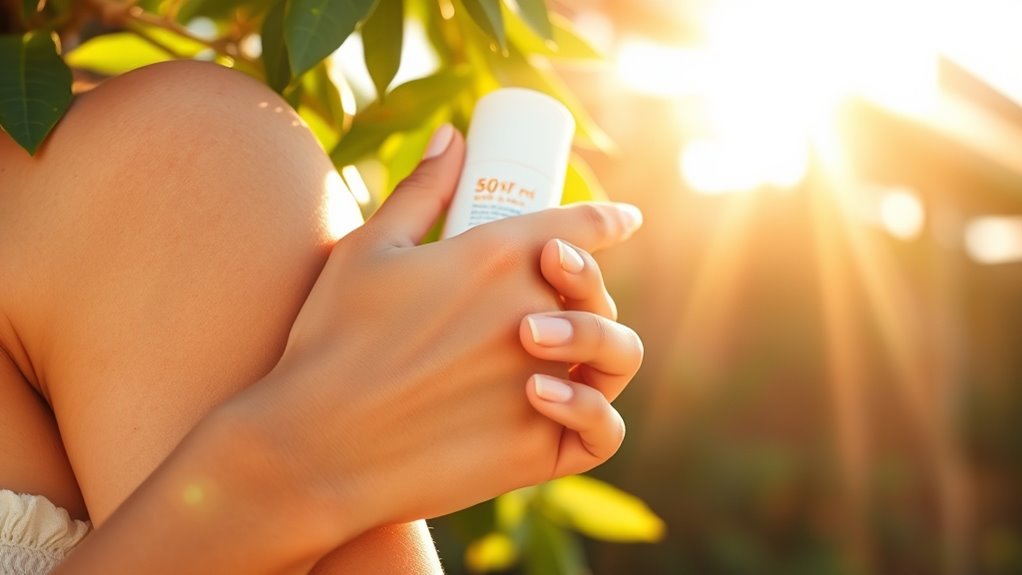
Choosing the right sunscreen begins with understanding your skin type and its specific needs. If you have sensitive skin, look for products with natural ingredients that minimize irritation. Here are three tips to help you select the best option:
- Opt for mineral sunscreens with zinc oxide or titanium dioxide, ideal for sensitive skin.
- Check labels for natural ingredients that soothe and protect without causing reactions.
- Choose formulas designed for your skin type—whether oily, dry, or sensitive—to guarantee effective protection without clogging pores.
- Additionally, consider sunscreens with UV protection properties to ensure comprehensive defense against harmful rays.
Benefits of Broad-Spectrum Protection
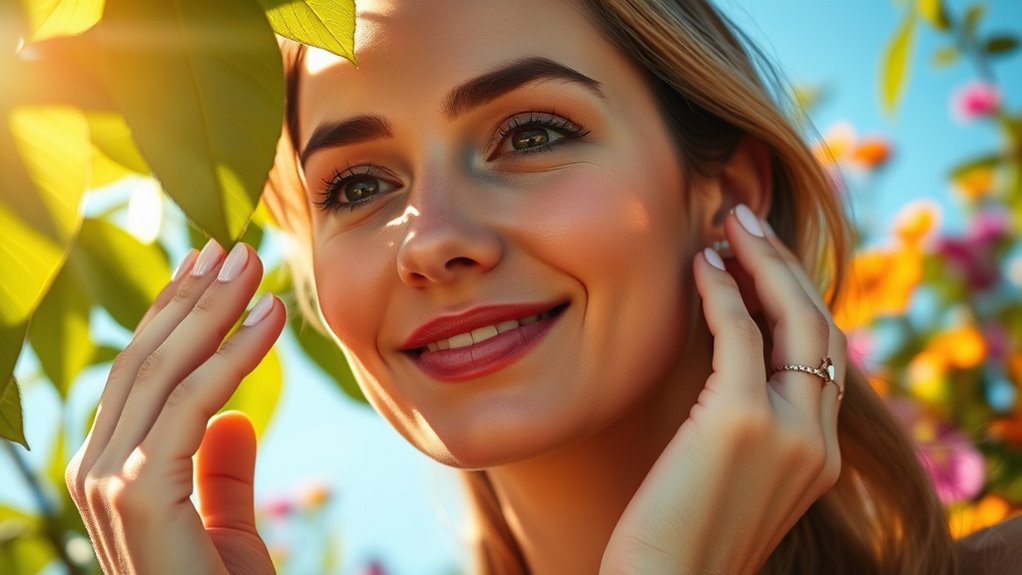
Broad-spectrum protection shields your skin from both UVA and UVB rays, reducing the risk of damage. It also helps prevent premature aging and keeps your skin healthier over time. Choosing this type of sunscreen offers all-encompassing defense for your skin’s long-term well-being. Incorporating mindful skincare practices can further enhance your protection and overall skin health.
Shields Against UV Damage
Because UV rays can penetrate the skin and cause damage, using skincare products with broad-spectrum protection is essential for effective defense. These products shield you from both UVA and UVB rays, reducing your risk of skin damage. Did you know that some surfaces reflect UV rays, increasing exposure? That’s UV reflection in action, making broad-spectrum protection even more important. Many sun protection myths, like believing sunscreen isn’t necessary on cloudy days, can lead to harm. To stay protected, consider these key points: 1. Broad-spectrum formulas guard against a wide range of UV radiation. 2. They help prevent skin damage caused by reflected UV rays. 3. Relying on myths can leave you vulnerable to unseen UV damage. Choosing the right protection ensures you’re shielded from UV damage effectively. Additionally, sunscreen application techniques can significantly improve your overall sun protection.
Prevents Premature Aging
Since UV rays can penetrate deep into the skin and accelerate aging, using protection that blocks both UVA and UVB rays is essential for maintaining a youthful appearance. Broad-spectrum solar protection shields your skin from these harmful rays, preventing the formation of fine lines, wrinkles, and age spots. By consistently applying sunscreen, you reduce the risk of skin aging caused by sun exposure. Here’s a quick look at how broad-spectrum protection benefits you:
| Benefit | Explanation |
|---|---|
| Reduces Wrinkles | Blocks UV rays that break down collagen |
| Prevents Age Spots | Stops pigmentation caused by sun damage |
| Maintains Skin Elasticity | Protects collagen and elastin fibers |
Invest in quality sun protection to keep your skin looking youthful longer.
Adding skin aging as a factor influenced by sun exposure highlights the importance of proper protection.
Supports Skin Health
Supporting your skin’s health starts with protecting it from the sun’s harmful rays, which can cause damage beyond just aging. When you wear broad-spectrum sunscreen, you help maintain your skin’s overall well-being. It allows your body to produce enough vitamin D without risking overexposure. Without protection, you increase tanning risks that can lead to burns and skin cancer. Incorporating protective styling benefits like wide-brim hats and UV-protective clothing can further enhance your sun safety routine.
Protective Clothing and Accessories
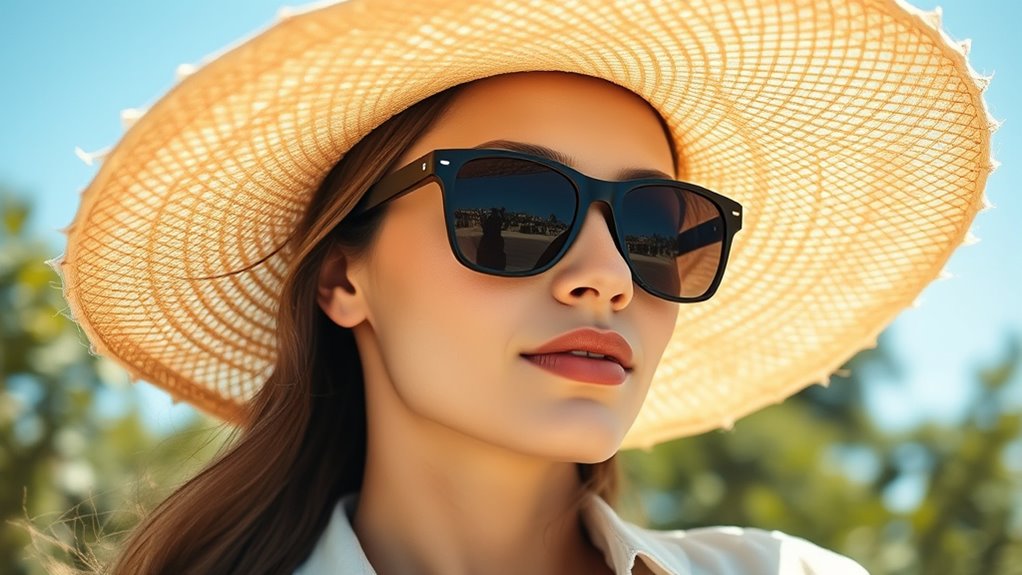
Wearing protective clothing and accessories is an effective way to shield your skin from harmful UV rays. UV protective hats provide a broad brim that covers your face, neck, and ears, reducing sun exposure in vulnerable areas. Pair these with UV blocking sunglasses to protect your eyes and the surrounding skin from UV damage. Lightweight, long-sleeved shirts made from tightly woven fabrics act as a barrier against UV rays, offering additional protection. When choosing accessories, look for items labeled with UPF (Ultraviolet Protection Factor) ratings for maximum effectiveness. These clothing pieces and accessories are especially useful during peak sun hours or outdoor activities, helping you maintain healthy skin and prevent sun damage. Incorporating protective clothing and accessories into your routine is a simple yet powerful step in skincare. Dirt Cups are a fun and easy dessert that can be enjoyed as a cool treat after outdoor activities, making them a perfect complement to sun protection efforts.
Timing Your Sun Exposure
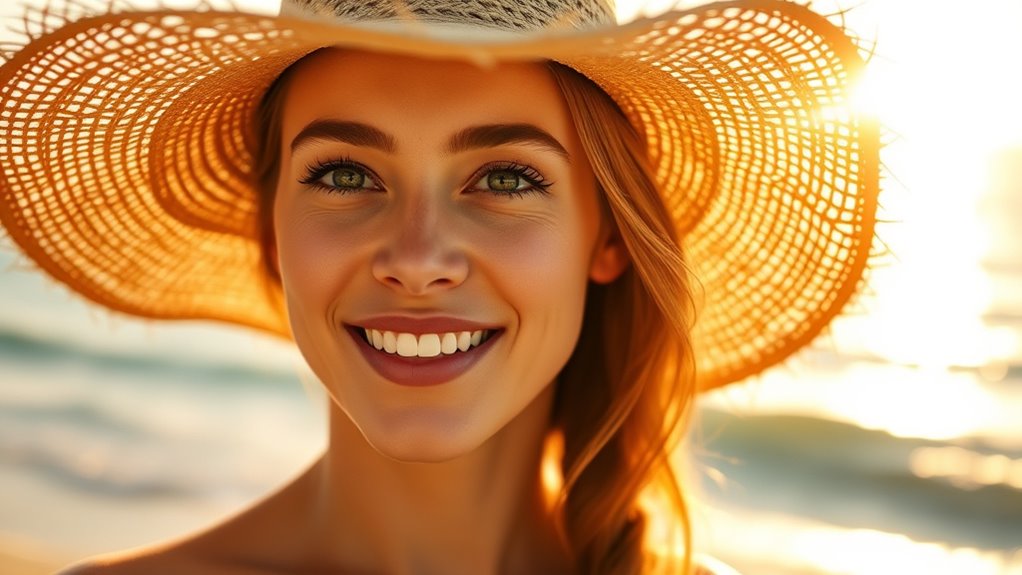
To protect your skin, plan your outdoor time wisely by focusing on the hours when the sun’s rays are less intense. Typically, early mornings and late afternoons offer safer exposure, while midday hours pose the highest risk. By adjusting your schedule, you can enjoy the sun without overexposing your skin. Additionally, using appropriate sun protection measures can further reduce the risk of damage during your outdoor activities.
Optimal Sun Exposure Hours
Choosing the right time for sun exposure can considerably reduce your risk of skin damage. To protect your skin, aim for hours when the sun’s rays are less intense. Generally, this means early mornings or late afternoons. Here are some ways to optimize your time outside:
- Take beach strolls or outdoor workouts during the early morning or late afternoon.
- Avoid peak hours between 10 a.m. and 4 p.m., when UV rays are strongest.
- Plan outdoor activities around these times to minimize skin exposure to harmful rays.
- Staying aware of AI safety developments can help inform better protective measures against UV-related skin risks.
Avoid Peak Intensity
Since UV rays are most intense between 10 a.m. and 4 p.m., timing your sun exposure outside these hours considerably lowers your risk of skin damage. To practice effective sun avoidance, plan outdoor activities early in the morning or late in the afternoon. Shade strategies, such as seeking shade under trees or umbrellas, further reduce UV exposure. Incorporate protective clothing and broad-spectrum sunscreen when you must be outdoors during peak hours.
| Time of Day | Sun Exposure Tips |
|---|---|
| Before 10 a.m. | Enjoy outdoor activities with minimal risk |
| 10 a.m. – 4 p.m. | Seek shade, limit direct sun, use protection |
| After 4 p.m. | Continue outdoor activities safely |
Daily Habits for Better Sun Defense

Establishing simple daily habits can considerably boost your sun defense. Consistent routines make a real difference in protecting your skin from UV damage. Here are three key habits to incorporate:
- Apply sunscreen generously every morning, even on cloudy days, as part of your daily skincare routine.
- Reapply sunscreen every two hours when outdoors, especially after sweating or swimming.
- Wear protective accessories like hats, sunglasses, and lightweight clothing to shield your skin naturally.
- Choosing the right projector technology can also help in reducing eye strain during long viewing sessions.
Myths and Facts About Sun Protection
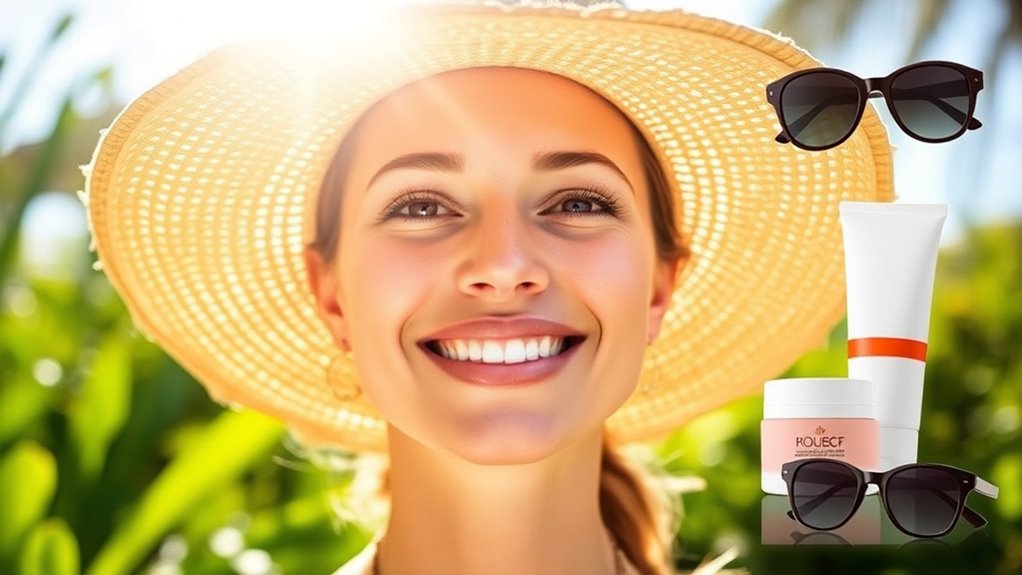
Many people believe certain myths about sun protection that can lead to risky behaviors. Myth busting is vital to clear up misconceptions and guarantee you stay protected. One common myth is that you only need sunscreen on sunny days, but UV rays penetrate clouds, so daily application is essential. Another false belief is that a higher SPF offers substantially longer protection; however, SPF mainly indicates UVB defense, not overall protection. Fact verification shows that reapplying sunscreen every two hours is necessary, especially after sweating or swimming. Some think tanning is safe, but it damages your skin and increases cancer risk. By understanding these facts, you can make smarter choices and effectively safeguard your skin from harmful UV rays. Correcting these myths empowers you to practice true sun safety.
Long-Term Benefits of Consistent Sun Safety

Practicing consistent sun safety offers significant long-term benefits for your skin and overall health. By sticking to effective sun safety routines, you not only protect yourself from harmful UV rays today but also prevent skin aging and damage over time. When you prioritize daily sun protection, you reduce the risk of premature wrinkles, dark spots, and skin cancers. Here are some key benefits:
Consistent sun safety protects your skin now and prevents aging and damage in the future.
- Preservation of youthful skin appearance
- Reduced risk of skin-related health issues
- Fewer costly treatments in the future
These benefits highlight how maintaining good sun safety routines now can lead to healthier, more resilient skin long-term. Consistency is essential—your future self will thank you for your commitment to skin aging prevention through sun safety.
Frequently Asked Questions
How Does Sun Exposure Affect Skin Pigmentation Changes?
Sun exposure increases your skin’s melanin production, which can lead to pigmentation changes. When you spend too much time in the sun, it boosts hyperpigmentation risk, causing dark spots and uneven skin tone. UV rays stimulate melanin, the pigment responsible for skin color, making existing pigmentation darker and encouraging new spots. Protecting your skin helps prevent these changes, keeping your complexion even and reducing hyperpigmentation risk.
Can Certain Medications Increase Sun Sensitivity?
Did you know that certain medications cause reactions that increase your skin sensitivity to sunlight by up to 50%? Some drugs, like antibiotics and antihistamines, can trigger medication reactions that make you more vulnerable to sun damage. When you take these medications, your skin becomes more sensitive to UV rays, raising your risk of burns and pigmentation changes. Always check medication labels and consult your doctor about potential sun sensitivity.
Are There Natural or Organic Sunscreens Effective Enough?
You might wonder if natural or organic sunscreens work well. The good news is, many with natural ingredients and organic formulations can be effective, especially if they contain mineral filters like zinc oxide or titanium dioxide. These ingredients provide broad-spectrum protection without harmful chemicals. Just make sure to choose products labeled as broad-spectrum and have adequate SPF, and reapply regularly for the best protection.
How Does Sun Protection Differ for Various Skin Tones?
Did you know that darker skin tones have about 10 times more melanin, offering some natural protection? For your skin tone considerations, it’s vital to customize SPF levels, as lighter skin needs higher SPF for effective protection, while darker skin still requires sun care to prevent damage. Understanding your skin’s unique needs helps you choose the right sunscreen, ensuring best protection tailored to your skin tone.
What Are the Signs of Sun Damage That Appear Later in Life?
You might notice aging signs like wrinkles, fine lines, and uneven skin tone later in life. Sun damage reduces your skin’s elasticity, making it saggy and less firm. Over time, you could see dark spots or age spots, and your skin may become rougher or thinner. These signs develop gradually, highlighting how vital it is to protect your skin from sun exposure now to maintain its youthful appearance later.
Conclusion
Think of your skin like a delicate garden—you wouldn’t leave it unwatered and exposed to harsh elements. By consistently applying sunscreen, wearing protective clothing, and avoiding peak sun hours, you’re nurturing it against damage. Just like a garden flourishes with care, your skin thrives when protected. Remember, the habits you build today safeguard your radiant glow tomorrow—so stay vigilant, and let your skin bloom age gracefully.
